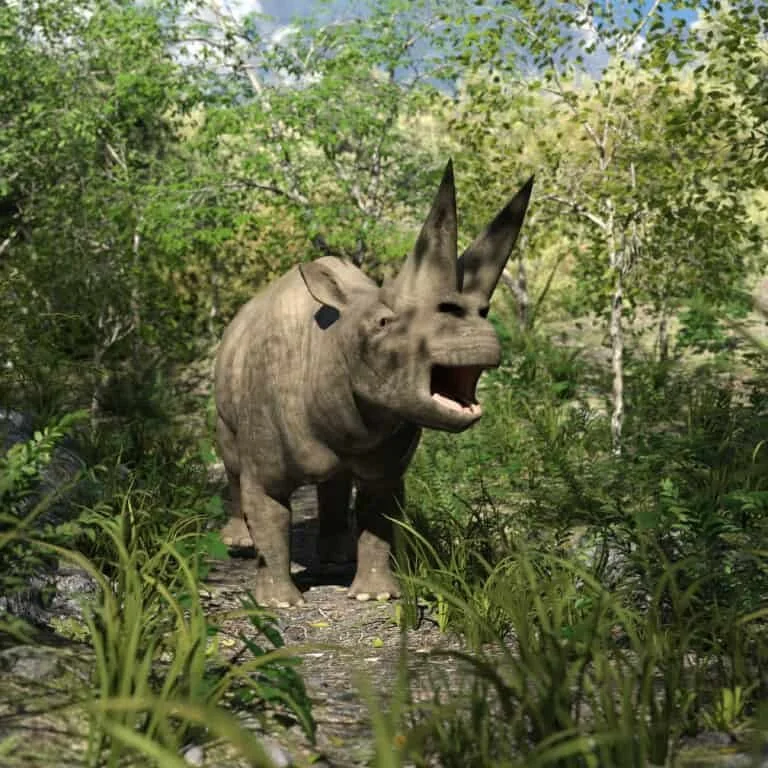The twin-horned Arsinoitherium was more closely linked to modern elephants than rhinos, despite having a similar appearance. Between the Late Eocene and Middle Oligocene eras (45 to 24 million years ago), this extinct genus made its home in Africa and the Arabian Peninsula. Along with existing animals like elephants, manatees, and hyraxes, Arsinoitherium is a genus of paenungulata mammals (nearly hoofed mammals).
Arsinoitherium’s horns were hollow.
Description & Size
A genus of extinct big animals known as Arsinoitherium was found in deposits from the Eocene Epoch, which lasted from 56 million to 34 million years ago. Members of the genus lived throughout the Oligocene Epoch, which occurred between 34 million and 23 million years ago, according to a more recent discovery in other areas.
After Queen Arsinoe I of Ancient Egypt, the species Arsinoitherium was named. She is commemorated by the Faiyum Oasis, the location of the earliest fossils of the genus. This fact is alluded to in the genus name. Arsinoitherium is a member of the extinct Embrithopoda order. Arsinoitherium zitteli and Arsinoitherium giganteus are two well-known species of the genus.
When it comes to appearance, Arsinoitherium is frequently compared to a whimsical rhinoceros. On the nasal bones, it had two huge horns, and on the frontal bones, it had a smaller pair of horns. This mammal's dimensions are similar to those of a huge white rhinoceros. Arsinoitheriums might grow as long as 3.5 meters (11 feet). At the shoulders, they were roughly 1.75 m (5.7 feet) tall.
Arsinoitherium's skeletal system is remarkably similar to that of elephants. They possessed skulls, feet, and hips that resembled elephants. Their twin horns, which could reach a length of up to 2.5 feet, were hollow and constructed of a bone substance similar to that of contemporary cows. The horns most likely possessed a keratin layer that prevented them from breaking. Although both sexes had horns, some scientists have hypothesized that the size of the horns varied according to gender.
3D illustration of a Arsinoitherium
Diet – What Did Arsinoitherium Eat?
Arsenoitherium was a herbivore that foraged. However, palaeontologists believe it had a specific diet based on the particular tooth structure and jaw muscles. It might have consumed the many bulky fruits and grasses that were present at the Egyptian site of Fayoum Oasis, where it was discovered.
Habitat – When and Where It lived
The Arsinoitherium genus included large, sluggish creatures. It is generally accepted that they, like modern hippos, resided in swamps and semi-aquatic environments. Instead of swinging forward, their forelimbs were designed to pull firmly backward. This trait is typical of animals that prefer to drag themselves across marshes, sticky soils, and other types of shallow water.
The majority of the fossils discovered thus far were found in sediments resembling warm, humid lowland forests with dense vegetation or coastal swamp settings. From the Late Eocene through the Middle Oligocene, the Arsinoitherium was among the largest mammals in Africa and the Arabian Peninsula.
Threats And Predators
Given their enormous size, these mammals had no significant predators that could feed on them. Arsinoitherium didn't need to run because it had no predators to flee from, according to scientists, who say that is why its limbs weren't built for rapid movement.
Discoveries and Fossils – Where It Was Found
The first Arsinoitherium fossils were discovered by paleontologists in the Jebel Qatrani strata of the Egyptian Fayum Oasis. In the Late Eocene to Early Oligocene sediments at this location, there were full bones of this mammal.
The fossil was found in 1901 by paleontologist H. L. Beadnell, who gave it the name Arsinoitherium zitteli a year or so later. The name of the genus, Arsinoitherium, refers to Egyptian Queen Arsinoe I and means "Arsinoe's Beast." The most well-known species in this genus is A. zitteli.
More recently, a larger and more recent species was identified. 2004 saw the discovery of fresh Arsinoitherium fossils by paleontologists researching in Ethiopia's Chilga region. The newly discovered species was around 25% larger than A. zitelli based on tooth comparisons. Arsinoitherium giganteus is the name given to it.
Along with these noteworthy discoveries, paleontologists have discovered a number of fossil fragments, mostly teeth, that belonged to an unidentified species within the genus. Arsinoitherium fossil fragments of an unidentified specie have been discovered in numerous locations throughout Africa and the Middle East.
Extinction – When Did Arsinoitherium Die Out?
About 27 million years ago, arsinoitheriums went extinct. Scientists believe that climate change was the primary factor in the extinction of these and the majority of the other great mammals that were around at the time.
During the Late Eocene, there were significant climatic changes that caused the habitat of Arsinoitherium to be disturbed. The hot, muggy weather changed to a considerably chilly one. Due to this, their moist forested environment was lost, and grasslands and savannahs, which are currently common throughout most of Africa, began to grow.
A few Arsinoitherium persisted for a while in a restricted area of woodland habitats. But as the temperature dropped, grasslands began to appear all over Northern Africa. The Arsinoitherium totally lost their habitat and food source by the Middle Oligocene, which resulted in their extinction.











